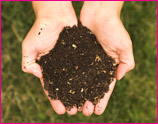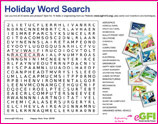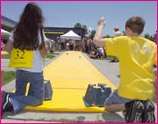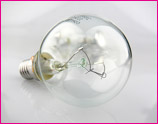Posted on December 22nd, 2009 by ASEE
 In this lesson, students in grades K-5 learn how decaying organic matter can be harvested as a source of energy. After brainstorming as to how old metal, plastic, and paper can be a resource, students find uses for an old piece of fruit. They view an informative video on harvesting organic material for energy. Once their their investigation is complete, students observe conditions that promote the most rapid decay of a piece of fruit.
In this lesson, students in grades K-5 learn how decaying organic matter can be harvested as a source of energy. After brainstorming as to how old metal, plastic, and paper can be a resource, students find uses for an old piece of fruit. They view an informative video on harvesting organic material for energy. Once their their investigation is complete, students observe conditions that promote the most rapid decay of a piece of fruit.
Read More
Filed under: Grades K-5, Lesson Plans | Comments Off on Lesson: The Energy of Decay
Tags: Environmental Engineering, Grades K-5, Recycling, Waste management
Posted on December 16th, 2009 by ASEE
 In this lesson for grades 5-8, students learn how the process of reverse engineering helps improve technology. Students analyze the mechanisms of a push-toy then disassemble it and draw its inner mechanisms. They then make suggestions for improvements: effectiveness, improved functionality, ecological friendliness, and any additional functionality. Time required: 90 minutes.
In this lesson for grades 5-8, students learn how the process of reverse engineering helps improve technology. Students analyze the mechanisms of a push-toy then disassemble it and draw its inner mechanisms. They then make suggestions for improvements: effectiveness, improved functionality, ecological friendliness, and any additional functionality. Time required: 90 minutes.
Read More
Filed under: Class Activities, Grades 6-8, Grades 6-8, Grades K-5, Grades K-5, Lesson Plans | 1 Comment »
Tags: Design, Grades 6-8, Grades K-5
Posted on December 7th, 2009 by ASEE

As classes wind down (or up!) for the holidays, here’s a fun activity to get students thinking about engineering. It a game families can enjoy, too. Print and distribute copies of this pdf puzzler, directing students to locate as many words as possible.
Read More
Filed under: Class Activities, Grades 6-8, Grades 9-12 | Comments Off on Engineering Word Search
Tags: Class Activities, Fun & Games, Grades 6-8, Grades 9-12, Grades K-5
Posted on December 2nd, 2009 by ASEE

In this essay contest of EngineerGirl!, National Academy of Engineering, students are challenged to think like an engineer to solve a survival problem. In their essays, they must describe how to use the contents of a backpack and the surrounding environment to create shelter, gather food and water, or summon rescue. Please see the full description here or on the website for the specific requirements of this contest. Deadline: March 1, 2010.
Read More
Filed under: K-12 Outreach Programs | Comments Off on K-12 Essay Contest: Survival Design
Tags: Design, Essay Contest, Grades 6-8, Grades 9-12, Grades K-5
Posted on December 2nd, 2009 by ASEE

The EngineerGirl Website, a project of the National Academy of Engineering (NAE), features resources and links helpful for any classroom, including: fun facts, cool links, great achievements, and engineering contests.
Read More
Filed under: Web Resources | Comments Off on Website: NAE’s Engineer Girl!
Tags: Engineering in History, Fun Facts, Grades 6-8, Grades 9-12, Grades K-5, Programs for Girls, Web Resources, Website, Women in Engineering
Posted on November 30th, 2009 by ASEE

Disney’s Planet Challenge project-based environmental competition for 4th – 6th grade classrooms invites students to identify a local environmental issue and devise a solution that they manage and document from start to finish. Classrooms develop a portfolio to be evaluated on environmental-relevance, student learning, changes in practices and attitudes, community involvement, lasting benefits to students, school and/or community and originality. A array of national, state, and regional prizes are offered. Application deadline: Dec. 18, 2009
Read More
Filed under: Grades 6-8, K-12 Education News, K-12 Outreach Programs, Web Resources | Comments Off on Disney’s Green Classroom Challenge, Dec. 18, 2009
Tags: Competitions for Students, Environmental Engineering, Grades 6-8, Grades K-5
Posted on November 25th, 2009 by ASEE
 A treasure trove of resources for grades 3-6, the DragonflyTV website enriches the popular PBS science T.V. programs of the same name. It features a page of experiment activities; various videoes; a focus on nanotechnology; and games, puzzlers, and riddles.
A treasure trove of resources for grades 3-6, the DragonflyTV website enriches the popular PBS science T.V. programs of the same name. It features a page of experiment activities; various videoes; a focus on nanotechnology; and games, puzzlers, and riddles.
Read More
Filed under: Web Resources | Comments Off on Website: PBS’s DragonflyTV
Tags: biography, games, Grades 6-8, Grades K-5, Nanotechnology
Posted on November 25th, 2009 by ASEE

The Florida Solar Energy Center, a research arm of the University of Central Florida, has developed downloadable sets of curriculum materials for K-12 teachers and schools on alternative energy sources, including solar, photovoltaics, hydrogen, and fuel cells. The Website lists descriptions of these curriculum materials, links to web sites, and information on each unit. Care has been taken to insure that the proper state standards that apply have been maintained.
Read More
Filed under: Web Resources | Comments Off on Curriculum: Solar, Alternative Energy
Tags: Alternative Energy, Class Activities, Curriculum, Grades 6-8, Grades 9-12, Grades K-5, Lesson Plans, Solar Engineering
Posted on November 18th, 2009 by Jaimie Schock
 In this single-session activity, students in grades 1-5 participate in a hands-on science investigation of electricity. They learn through discovery about how electricity works. Students’ natural curiosity and sense of exploration enable them to explore and learn on their own with minimal input from the teacher.
In this single-session activity, students in grades 1-5 participate in a hands-on science investigation of electricity. They learn through discovery about how electricity works. Students’ natural curiosity and sense of exploration enable them to explore and learn on their own with minimal input from the teacher.
Read More
Filed under: Class Activities, Grades K-5 | 1 Comment »
Tags: Class Activities, Electrical, Grades K-5
 In this lesson, students in grades K-5 learn how decaying organic matter can be harvested as a source of energy. After brainstorming as to how old metal, plastic, and paper can be a resource, students find uses for an old piece of fruit. They view an informative video on harvesting organic material for energy. Once their their investigation is complete, students observe conditions that promote the most rapid decay of a piece of fruit.
In this lesson, students in grades K-5 learn how decaying organic matter can be harvested as a source of energy. After brainstorming as to how old metal, plastic, and paper can be a resource, students find uses for an old piece of fruit. They view an informative video on harvesting organic material for energy. Once their their investigation is complete, students observe conditions that promote the most rapid decay of a piece of fruit.








 In this lesson for grades 5-8, students learn how the process of reverse engineering helps improve technology. Students analyze the mechanisms of a push-toy then disassemble it and draw its inner mechanisms. They then make suggestions for improvements: effectiveness, improved functionality, ecological friendliness, and any additional functionality. Time required: 90 minutes.
In this lesson for grades 5-8, students learn how the process of reverse engineering helps improve technology. Students analyze the mechanisms of a push-toy then disassemble it and draw its inner mechanisms. They then make suggestions for improvements: effectiveness, improved functionality, ecological friendliness, and any additional functionality. Time required: 90 minutes.



 A treasure trove of resources for grades 3-6, the DragonflyTV website enriches the popular PBS science T.V. programs of the same name. It features a page of experiment activities; various videoes; a focus on nanotechnology; and games, puzzlers, and riddles.
A treasure trove of resources for grades 3-6, the DragonflyTV website enriches the popular PBS science T.V. programs of the same name. It features a page of experiment activities; various videoes; a focus on nanotechnology; and games, puzzlers, and riddles.
 In this single-session activity, students in grades 1-5 participate in a hands-on science investigation of electricity. They learn through discovery about how electricity works. Students’ natural curiosity and sense of exploration enable them to explore and learn on their own with minimal input from the teacher.
In this single-session activity, students in grades 1-5 participate in a hands-on science investigation of electricity. They learn through discovery about how electricity works. Students’ natural curiosity and sense of exploration enable them to explore and learn on their own with minimal input from the teacher.